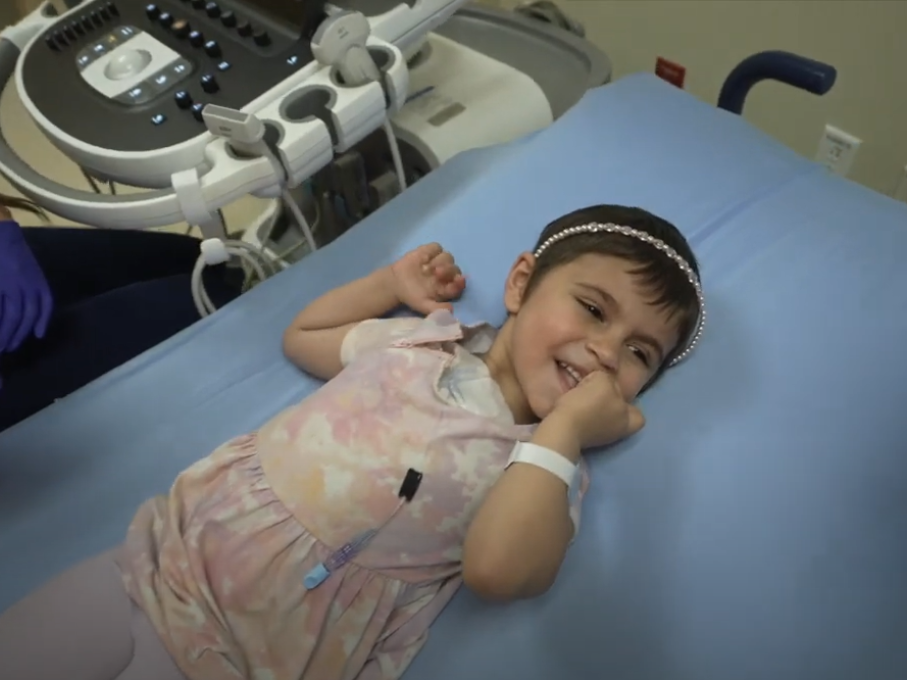What is an Ultrasound?
An ultrasound uses high frequency sound waves to safely take pictures of the tissues and organs inside your child’s body. These sound waves are completely painless and produce no radiation, so it is a great option for imaging children.
Fun Fact: Did you know that dolphins use ultrasound to help them see under water? Commonly referred to as echolocation or sonar, dolphins use ultrasound to see the ocean around them.
At Phoenix Children’s, we have been able to substitute ultrasound for radiation-based exams to evaluate appendicitis and bowel obstruction. We’ve also pioneered the use of ultrasound for treating and monitoring multiple conditions, which include slipping rib syndrome and MAGEC® growing rods for children with spinal deformities.
How to Prepare for an Ultrasound
You will receive specific instructions prior to your child’s appointment and our child life specialists can work with you to help prepare your child for their visit. This can help alleviate any anxiety, so they have the best experience possible.
Typically, there is no special preparation needed for this test, but here are a few tips to help prepare for the exam and answers to some frequently asked questions:
- Take time to talk to your child and explain the test. Reassure them they’ll be safe and comfortable.
- For preschoolers, it’s best to discuss the day of the scan.
- For school-aged children, it’s best to discuss two to three days before.
- For adolescents, it's best to discuss one to two weeks before.
- Bring a comfort item, such as a stuffed animal, toy or blanket to use during waiting times or in the imaging room.
- Dress your child in comfortable clothing.
- If your child requires sedation, you will receive additional instructions before the scan.
It depends. There are many different types of ultrasound exams and each one may have different preparation instructions. It is very important to follow the instructions given to you when scheduling your ultrasound.
Your child should continue to take their usual medications as prescribed by their doctor before the ultrasound, unless given other instructions by your doctor or nurse.
If your child’s exam is ordered with contrast, then a radiology nurse will place a small catheter, called an IV, before the ultrasound.
If your child has ever had a reaction or allergy to a contrast agent used for ultrasound, please tell your child’s nurse, doctor, and the sonographer before the ultrasound begins. The contrast used for an ultrasound is not the same contrast that is used for CT, MRI, or X-ray imaging.
- Look: Walking into an ultrasound room, you will see a bed sitting next to a large computer on wheels. There are usually several cameras (transducers) that look like magic wands attached to the computer. Since there is no radiation in ultrasound, a caregiver can stay in the room for the entire exam. The sonographer will dim the lights during the ultrasound so they can see the pictures on their screen better.
- Sound: The ultrasound machine is actually very quiet. The sound waves used to take pictures are higher pitched than humans can hear and is why it's called ULTRA-sound. We use ultra-high frequency sound to take pictures. The one thing you may hear is the machine making a small beep and means that the sonographer is taking a picture. During the ultrasound, you can ask to listen to music or even watch a movie.
- Feel: Ultrasound does not hurt. Some patients may experience some discomfort if the area being scanned is painful. The one thing your child will feel is the ultrasound gel and a lot of children say the gel feels like lotion. Gel is used to help the sound waves pass into the body and it also helps the camera glide smoothly over their skin.
What to Expect During an Ultrasound
It’s totally natural for your child to be a little nervous but knowing what to expect can help. Here’s what your child can expect during the exam:
- After getting checked in at our front desk, a sonographer will walk you to the ultrasound room. Your child will lie on a bed and the sonographer will explain the exam process. An ultrasound is safe and there is no radiation, so you are welcome to sit with your child during the ultrasound exam and ask questions.
- Generally, your child will start out lying on their back for their ultrasound. The sonographer may ask for your child to roll onto their side or move into a different position during the exam. Sometimes the sonographer may ask your child to take a deep breath and hold it. During the exam, it can be important to hold still to obtain the best images possible. When the exam is complete, we will use towels to wipe off any remaining gel.
- The ultrasound images will be sent to a pediatric radiologist to review. A radiologist is a specially trained doctor who specializes in interpreting images of the body. The radiologist will make a report of the findings which will be sent to the provider who ordered the exam.
- This process typically takes between one to three business days and results will be provided to your referring provider. Please note: the ultrasound staff will not be able to provide information on the exam findings.

Patient Resources
These materials from our Child Life team can help guide your discussion with your child about their ultrasound:
